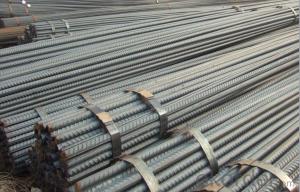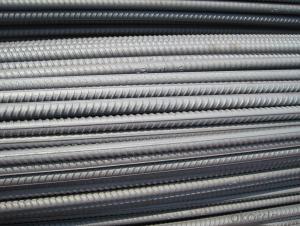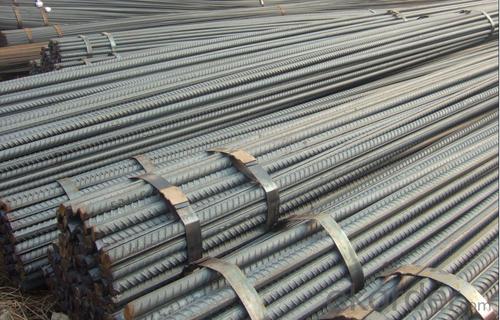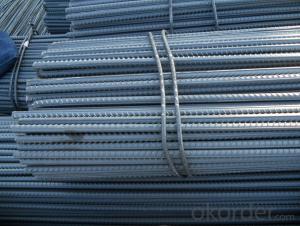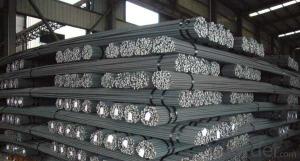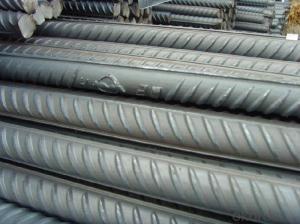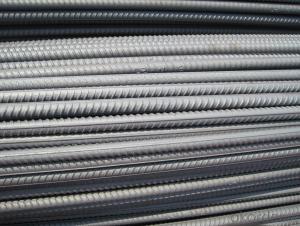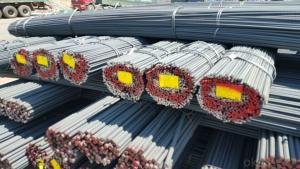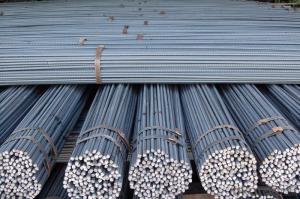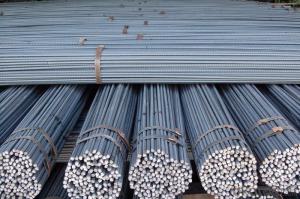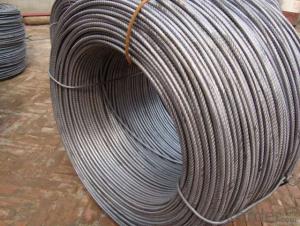GB Standard HRB400 Steel Deformed Bar 28mm/32mm
- Loading Port:
- Tianjin
- Payment Terms:
- TT or LC
- Min Order Qty:
- 50 m.t
- Supply Capability:
- 20000 m.t/month
OKorder Service Pledge
OKorder Financial Service
You Might Also Like
GB Standard HRB400 Steel Deformed Bar 28mm/32mm
Description:
-Standard: GB
-Material: HRB400
-Specification:
| Diameter(mm) | Section Area(mm2) | Mass(Kg/m) | Length(m) |
| 28 | 615.8 | 4.83 | 9, 12 or as customs' request |
| 32 | 804.2 | 6.31 | 9, 12 or as customs' request |
Chemical Composition(%) of GB Standard HRB400 Steel Deformed Bar 28mm/32mm:
| C | Mn | Si | S | P | V |
| ≤0.25 | ≤1.60 | ≤0.08 | ≤0.045 | ≤0.045 | 0.04-0.12 |
Mechanical Properties of GB Standard HRB400 Steel Deformed Bar 28mm/32mm:
Yield Strength (N/cm²) | Tensile Strength (N/cm²) | Elongation (%) |
≥400 | ≥570 | ≥14 |
Usage and Applications of GB Standard HRB400 Steel Deformed Bar 28mm/32mm:
Deformed bar is widely used in buildings, bridges, roads and other engineering construction. Big to highways, railways, bridges, culverts, tunnels, public facilities such as flood control, dam, small to housing construction, beam, column, wall and the foundation of the plate, deformed bar is an integral structure material. With the development of world economy and the vigorous development of infrastructure construction, real estate, the demand for deformed bar will be larger and larger.
Packaging & Delivery of GB Standard HRB400 Steel Deformed Bar 28mm/32mm:
Packaging Detail: products are packed in bundle and then shipped by container or bulk vessel, deformed bar is usually naked strapping delivery, when storing, please pay attention to moisture proof. The performance of rust will produce adverse effect.
Each bundle weight: 2-3MT, or as required
Payment term: TT or L/C
Delivery Detail: within 45 days after received advanced payment or LC.
Label: to be specified by customer, generally, each bundle has 1-2 labels
Trade terms: FOB, CFR, CIF
Images of GB Standard HRB400 Steel Deformed Bar 28mm/32mm:
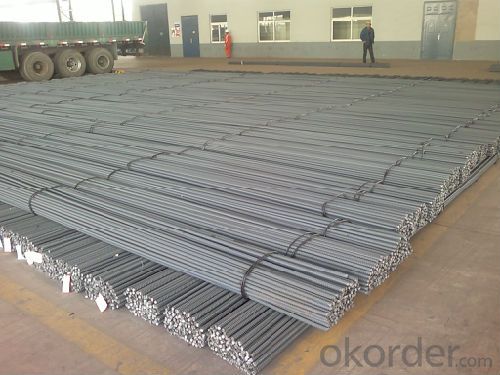

*If you would like to get our price, please inform us the size, standard/material and quantity. Thank you very much for your attention.
- Q: Can steel rebars corrode or rust over time?
- Yes, steel rebars can corrode or rust over time due to exposure to moisture and oxygen.
- Q: Can steel rebars be used in the construction of offshore oil platforms?
- Yes, steel rebars can be used in the construction of offshore oil platforms. Steel rebars provide structural reinforcement and enhance the strength and stability of the platform's concrete foundation. They are commonly used in various offshore structures due to their high tensile strength, durability, and resistance to corrosion in marine environments. Additionally, steel rebars can be designed to meet specific engineering requirements and contribute to the overall safety and longevity of the offshore oil platform.
- Q: What is the role of steel rebars in reducing concrete creep?
- Steel rebars play a crucial role in reducing concrete creep. Concrete creep refers to the gradual deformation or movement of concrete over time under sustained loading. This phenomenon occurs due to the long-term effects of stress and environmental factors on the concrete structure. By incorporating steel rebars into concrete structures, the creep behavior of concrete is significantly reduced. Steel rebars are high-strength reinforcement bars that are embedded within the concrete to enhance its structural integrity and durability. They provide tensile strength to counteract the tensile stresses that can cause concrete to creep. When concrete is subjected to sustained loads, such as the weight of a building or a bridge, it experiences internal stresses that can lead to creep. However, the presence of steel rebars helps to distribute these stresses more evenly throughout the structure. The rebars act as a reinforcement, absorbing and redistributing the tensile forces, thus minimizing the deformation of the concrete. Additionally, steel rebars also improve the bond between concrete and the reinforcement. This bond is essential for transferring the tensile forces from the concrete to the rebars and ensuring that they work together as a composite material. The strong bond between concrete and rebars prevents the formation of cracks, which can further contribute to creep. Furthermore, steel rebars also enhance the overall stiffness and rigidity of the concrete structure. This increased stiffness helps to resist the deformation caused by creep, maintaining the integrity and stability of the structure over time. In summary, the role of steel rebars in reducing concrete creep is vital. They provide tensile strength, distribute internal stresses, improve the bond between concrete and reinforcement, and enhance the overall stiffness of the structure. By incorporating steel rebars, engineers can effectively mitigate the effects of creep and ensure the long-term performance and durability of concrete structures.
- Q: Are steel rebars resistant to corrosion?
- Yes, steel rebars are resistant to corrosion due to their protective oxide layer, which prevents rust formation and ensures their durability in various construction applications.
- Q: What are steel rebars used for?
- Steel rebars are used in construction to provide strength and reinforcement to concrete structures, such as buildings, bridges, and highways.
- Q: Why is round bar more expensive than thread steel?
- Threaded steel should be used in the construction field, there are generally two, three grade steel, grade HRB335, HRB400 also has four grades, HRB500 thread steel.
- Q: What is the process of inspecting steel rebars for quality control?
- The process of inspecting steel rebars for quality control involves several steps to ensure that the rebars meet the required standards and specifications. Here is a general overview of the process: 1. Visual Inspection: The first step is to visually inspect the rebars for any visible defects such as cracks, surface imperfections, or irregularities in shape or size. This can be done manually or using automated systems that detect defects through image processing techniques. 2. Measurement and Dimensional Inspection: The rebars are then measured for their dimensions, including length, diameter, and shape. This is typically done using calibrated measuring instruments such as calipers, gauges, or laser-based devices. The measurements are compared against the specified tolerances to ensure compliance. 3. Chemical Analysis: A sample of rebars is taken and subjected to chemical analysis to determine the composition of the steel. This includes measuring the levels of carbon, manganese, sulfur, phosphorus, and other elements. The results are compared against the required chemical composition specified in the standards. 4. Mechanical Testing: Mechanical properties such as tensile strength, yield strength, elongation, and bendability are crucial for rebars used in construction. Samples are taken from the batch and tested in a laboratory using standardized tests, such as tensile testing machines, to ensure they meet the specified requirements. 5. Corrosion Resistance Testing: Rebars are often exposed to harsh environmental conditions, so it is important to assess their resistance to corrosion. This can be done through tests like salt spray testing or electrochemical methods to measure the rebars' corrosion resistance and ensure they will maintain their strength over time. 6. Weldability Testing: If rebars are intended for welding applications, their weldability is assessed. This includes evaluating the rebars' ability to form a strong and sound weld joint without any defects. Weldability tests may involve visual inspection, bend tests, or even destructive testing of welded samples. 7. Documentation and Certification: Throughout the inspection process, detailed records of all measurements, test results, and observations are documented. If the rebars pass all quality control tests, a certification or quality control report is issued, indicating that the rebars meet the required standards and specifications. It is worth noting that the specific inspection procedures may vary depending on the applicable standards, project requirements, and the type of rebar being inspected. Additionally, these inspections can be conducted by internal quality control teams or independent third-party inspection agencies to ensure impartiality and accuracy of the results.
- Q: How do steel rebars resist fatigue and creep?
- Steel rebars resist fatigue and creep due to their high tensile strength and ductility. The robustness of steel allows rebars to endure repeated loading cycles without experiencing significant fatigue damage. Additionally, the high stiffness and resistance to deformation of steel rebars prevent creep, which is the gradual deformation under sustained loads over time. Overall, the combination of strength, ductility, and stiffness in steel rebars enables them to withstand fatigue and creep effectively.
- Q: Do steel rebars increase the overall weight of a structure?
- Yes, steel rebars do increase the overall weight of a structure. Rebars are typically added to reinforce concrete structures, providing tensile strength to counteract the concrete's weakness in handling tension forces. Steel rebars are made of steel, which is a dense and heavy material. When incorporated into a structure, the weight of the rebars adds to the total weight of the construction. However, the additional weight is usually negligible compared to the overall weight of the structure, especially in large-scale projects. The benefits of using steel rebars in terms of structural integrity and durability far outweigh the minimal increase in weight they contribute.
- Q: Can steel rebars be used in wind turbine tower construction?
- Yes, steel rebars can be used in wind turbine tower construction. Rebars provide strength and structural support to the tower, ensuring its stability and ability to withstand strong winds.
Send your message to us
GB Standard HRB400 Steel Deformed Bar 28mm/32mm
- Loading Port:
- Tianjin
- Payment Terms:
- TT or LC
- Min Order Qty:
- 50 m.t
- Supply Capability:
- 20000 m.t/month
OKorder Service Pledge
OKorder Financial Service
Similar products
Hot products
Hot Searches
Related keywords
